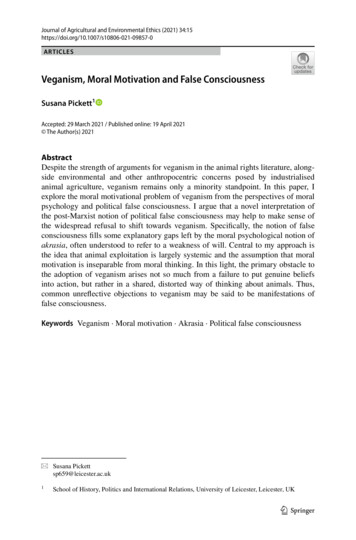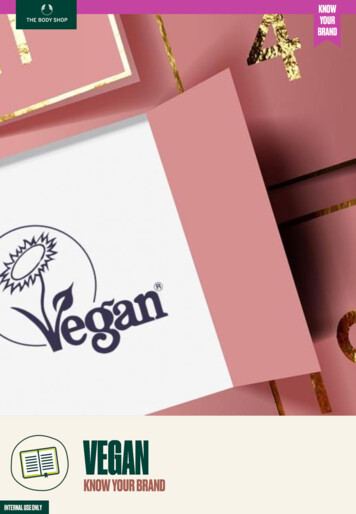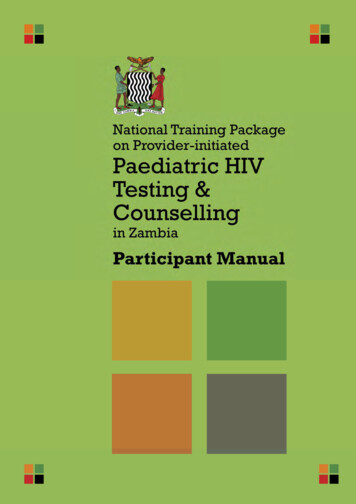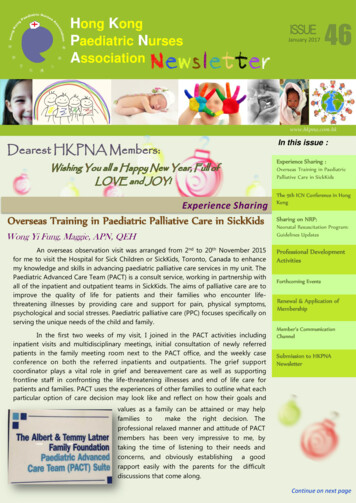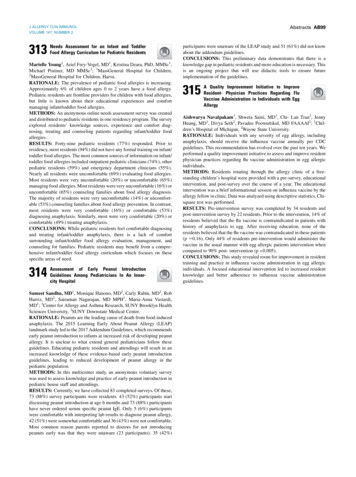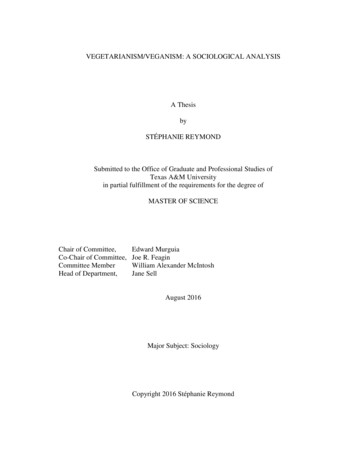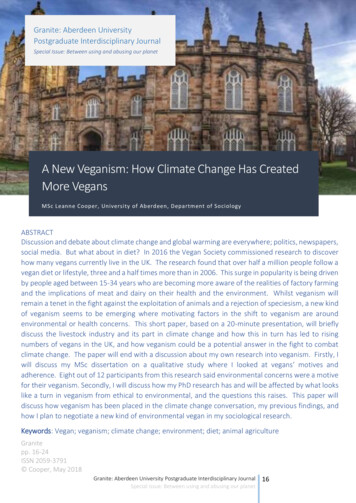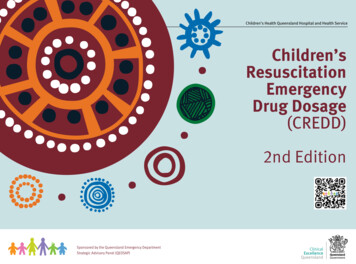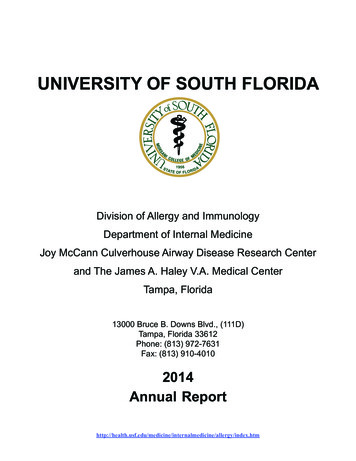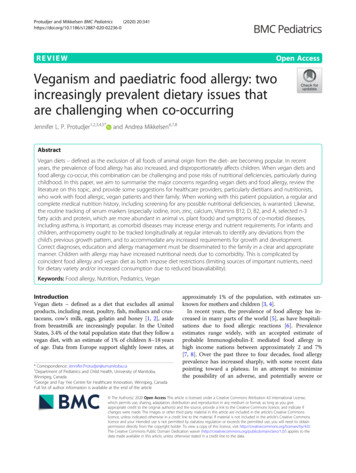
Transcription
Protudjer and Mikkelsen BMC Pediatrics(2020) VIEWOpen AccessVeganism and paediatric food allergy: twoincreasingly prevalent dietary issues thatare challenging when co-occurringJennifer L. P. Protudjer1,2,3,4,5*and Andrea Mikkelsen6,7,8AbstractVegan diets – defined as the exclusion of all foods of animal origin from the diet- are becoming popular. In recentyears, the prevalence of food allergy has also increased, and disproportionately affects children. When vegan diets andfood allergy co-occur, this combination can be challenging and pose risks of nutritional deficiencies, particularly duringchildhood. In this paper, we aim to summarise the major concerns regarding vegan diets and food allergy, review theliterature on this topic, and provide some suggestions for healthcare providers, particularly dietitians and nutritionists,who work with food allergic, vegan patients and their family. When working with this patient population, a regular andcomplete medical nutrition history, including screening for any possible nutritional deficiencies, is warranted. Likewise,the routine tracking of serum markers (especially iodine, iron, zinc, calcium, Vitamins B12, D, B2, and A, selected n-3fatty acids and protein, which are more abundant in animal vs. plant foods) and symptoms of co-morbid diseases,including asthma, is important, as comorbid diseases may increase energy and nutrient requirements. For infants andchildren, anthropometry ought to be tracked longitudinally at regular intervals to identify any deviations from thechild’s previous growth pattern, and to accommodate any increased requirements for growth and development.Correct diagnoses, education and allergy management must be disseminated to the family in a clear and appropriatemanner. Children with allergy may have increased nutritional needs due to comorbidity. This is complicated bycoincident food allergy and vegan diet as both impose diet restrictions (limiting sources of important nutrients, needfor dietary variety and/or increased consumption due to reduced bioavaliability).Keywords: Food allergy, Nutrition, Pediatrics, VeganIntroductionVegan diets – defined as a diet that excludes all animalproducts, including meat, poultry, fish, molluscs and crustaceans, cow’s milk, eggs, gelatin and honey [1, 2], asidefrom breastmilk are increasingly popular. In the UnitedStates, 3.4% of the total population state that they follow avegan diet, with an estimate of 1% of children 8–18 yearsof age. Data from Europe support slightly lower rates, at* Correspondence: Jennifer.Protudjer@umanitoba.ca1Department of Pediatrics and Child Health, University of Manitoba,Winnipeg, Canada2George and Fay Yee Centre for Healthcare Innovation, Winnipeg, CanadaFull list of author information is available at the end of the articleapproximately 1% of the population, with estimates unknown for mothers and children [3, 4].In recent years, the prevalence of food allergy has increased in many parts of the world [5], as have hospitalisations due to food allergic reactions [6]. Prevalenceestimates range widely, with an accepted estimate ofprobable Immunoglobulin-E mediated food allergy inhigh income nations between approximately 2 and 7%[7, 8]. Over the past three to four decades, food allergyprevalence has increased sharply, with some recent datapointing toward a plateau. In an attempt to minimizethe possibility of an adverse, and potentially severe or The Author(s). 2020 Open Access This article is licensed under a Creative Commons Attribution 4.0 International License,which permits use, sharing, adaptation, distribution and reproduction in any medium or format, as long as you giveappropriate credit to the original author(s) and the source, provide a link to the Creative Commons licence, and indicate ifchanges were made. The images or other third party material in this article are included in the article's Creative Commonslicence, unless indicated otherwise in a credit line to the material. If material is not included in the article's Creative Commonslicence and your intended use is not permitted by statutory regulation or exceeds the permitted use, you will need to obtainpermission directly from the copyright holder. To view a copy of this licence, visit http://creativecommons.org/licenses/by/4.0/.The Creative Commons Public Domain Dedication waiver ) applies to thedata made available in this article, unless otherwise stated in a credit line to the data.
Protudjer and Mikkelsen BMC Pediatrics(2020) 20:341even fatal reaction, food allergy necessitates exclusion ofthe allergenic food [5].Guidelines for vegan diets amongst paediatric patientsissued by national food administrations and/or nutritionsocieties in several countries, as well as international expert groups (including the European Society of Paediatric Gastroenterology, Hepatology and Nutrition; [ESPGHAN] [9]; Dietitians of Canada [10], and the AmericanAcademy of Nutrition and Dietetics [10]) now endorsewell-planned and carefully monitored vegan diets. Likewise, careful monitoring of food allergy is necessary toensure the nutritional needs of affected children are met[11]. At the intersection of veganism and food allergy,there are even greater concerns related to adequate micro- and macronutrient intakes that warrant careful consideration and monitoring. In this paper, we aimed tosummarise the major concerns regarding vegan dietsand food allergy, review the literature on this topic, andprovide some suggestions for healthcare providers, particularly dietitians and nutritionists, who work with afood allergic, vegan patient.Vegan diets: health benefits and risksPreviously, we have referred to a definition of vegan dietby what is eliminated. However, a vegan diet can also bedescribed as rich in a wide variety of foods: whole grains,legumes, vegetables, fruits, nuts, seeds, vegetable fats,herbs and spices [3]. The high amount of macro- andmicronutrients, as well as a wide variety of carbohydratetypes seems to enhance the development of a diverse intestinal flora [12, 13], of increasing interest in diseaseprevention [14]. Benefits of, and reasons for adopting avegan diet range widely, and include animal welfare [15],health benefits [15–17], personal well-being [15], improvement of disease symptoms [18], increased meatprices [19] and environmental concerns [20, 21].Recently, vegan diets were found to be an effectivemeans of prevention and treatment of cardiometabolicdisease [22, 23], with a decreased risk up to 40% of associated diseases. Moreover, the risk of metabolic syndrome and type 2 diabetes may be decreased by 50%,and, if well planned, can assist in reversing atherosclerosis, and reducing blood lipids and blood pressure.These health benefits may result, in part, from the observation that, compared to non-vegans, those followinga vegan diet have a lower body mass index (BMI) andwaist circumference. But there are some exceptions. In arecent meta-analysis, compared to a typical Taiwanesediet, vegan diets are not associated with improved cardiometabolic outcomes or lower BMI [23, 24].However, potential vegan diet pitfalls exist, particularlyamongst children. Young children may benefit from avariety of plant-based proteins during small and frequentmeals to allow for consumption of a large volume ofPage 2 of 11foods [3]. Whereas many of guidelines support vegan diets for infants and children [2, 12, 13, 25, 26], there aresome exceptions to these guidelines [27].Vegan diets and macronutrient deficienciesMuch of the literature on vegan diets and nutritional outcomes is based on adult populations [14, 22, 28–33]. Lessis known about vegan diets amongst infants and children.Thus, these age groups need to be carefully and routinelymonitored, if following a vegan diet [34]. Infants and children have higher energy and nutrient needs, which maybe difficult to achieve on a restricted diet. Recent data support that children to age 3 years following a vegan dietconsume adequate energy intake, but compared to omnivore children, significantly more carbohydrates (and fibre)and significantly less protein [35].Protein requirements in vegan diets are met mainlythrough vegetables, tofu, beans, whole grains, nuts andseeds. In order to achieve sufficient amounts of essentialamino acids, daily varied consumption is recommended[36]. As the above-mentioned foods often contain considerable amounts of fibre and anti-nutritional factors, i.e.substances that prevent optimal absorption of specific nutrients, protein intakes are recommended to be increasedby 10% during periods in life when protein needs arehigher. Two of these periods are infancy and childhood[3]. Protein needs can be met in a well-planned vegan diet,provided that the caloric need is met. For this reason,vegan protein-rich alternatives with less fibre, such as tofuand seitan, may be preferable since these foods usually result in high satiety and might support appropriate proteinintake [37, 38]. First results from a Swedish trial of infantsrandomized to a diet with decreased protein intake, compared to a traditional Nordic diet has, thus far, shown nogroup differences in growth or iron status at 9 months ofage [39]. Forthcoming results will glean further insightinto the role of decreased protein intake, compared to atraditional Nordic diet, on anthropometric outcomes,metabolic and inflammatory biomarkers, as well as the gutmicrobiome [40].These data notwithstanding, there are case reports ofalarming nutritional deficiencies as a consequence in whathas, sometimes been described as vegan diets. However,critical review of these reports can lead to the conclusionthat these children often have very restricted vegan dietswith limited caloric intake [41], or very limited foodchoices, for example extensive use of unfortified plantbased beverages [42]. In extreme situations, these restrictions may contribute to protein-calorie malnutrition [42],or kwashiorkor, in which the child consumes adequatecalories but inadequate protein [43] as well as inadequatemicronutrients [42]. Notably, these diets cannot be considered well-planned vegan diets, and any conclusions
Protudjer and Mikkelsen BMC Pediatrics(2020) 20:341regarding vegan diets for children based solely on these reports are misleading [3].Vegan diets and micronutrient deficienciesA poorly planned vegan diet can increase the risk ofmicronutrient deficiencies, particularly iodine, iron, zinc,calcium, Vitamin B12, Vitamin D, Vitamin B2, VitaminA, n-3 fatty acids (docosahexanoic acid; DHA).IodineIodine deficiency, which is poorly studied in high income nations, has been described in vegan infants whoare breastfed [44] or recently weaned [45]. In this instance, thyroid stimulating hormone levels should bemonitored and, if necessary, treated appropriately. In avegan diet, iodine requirements can be met with iodizedsalt or algal source supplements [3]. That said, it warrants mention that the amount of iodine in salt varies bycountry or region [46]. It also warrants mention thatcases of iodine deficiency amongst milk allergic infantswho receive inappropriate supplementation have beendescribed. In a Norwegian study of 57 infants aged 2years, 30% had urine iodine concentrations lower thanthe World Health Organization cut-off values [47].Amongst infants predominantly breastfed, this numberdoubled, to 58%. Notably, iodine deficiency was independent of poor growth status [47].Infant foods should not have added salt [12]. As such,iodine requirements are better met through breastmilk.A recent study found that breastmilk iodine concentrations were not associated with pre-pregnancy weight, although maternal diet was not considered in the analyses[48]. In contrast, the Centers for Disease Control andPrevention advises that the recommended daily allowance is 290 μg iodine for breastfeeding women, and thata supplement is indicated for women who do not consume dairy products [49]. Alternatively, legally sold commercial infant formulas fortified with iodine are widelyavailable, and are carefully regulated [50].IronTypical vegan diets often include many iron-rich foods,including lentils, tofu (soy), chickpeas, nuts, seeds andgrains. However, unlike iron from animal sources,termed heme iron, which is readily absorbed [51], nonheme iron from plants has poor bioavailability and lowerabsorption, due to high phytate and polyphenol levels[52]. Non-heme, plant-based sources of iron must alsobe consumed in larger portions than heme, animalbased sources of iron, to meet needs [53]. Vegans, aswell as vegetarians, require 1.8 times the amount of dietary iron, compared to meat eaters, as a result of poorerbioavailability [54]. Vitamin C may enhance the absorption of non-heme iron [55]. However, many veganPage 3 of 11sources of iron, particularly soy, nuts and sesame seeds,are also common food allergens. For children who arenot allergic, iron-fortified foods, including packaged cereals, may be an additional source of iron. Through laterinfancy, iron deficiency is the most prevalent micronutrient deficiency, thus highlighting the importance of adequate iron intake [56]. Amongst the very young, infantformulas and cereals are main sources of dietary iron[57]. After age 12 months, iron-fortified formulas arepositively associated with serum ferritin levels, independent of socio-economic status and other dietary sourcesof iron [56].But, even in the absence of allergies to common ironrich vegan foods, careful monitoring of these childrenmay be advised. In a study of infants with cow’s milk allergy, but otherwise well, iron deficiency anaemia wasidentified in 5% of children [58]. More strikingly, a retrospective study from Taiwan provides evidence that theprevalence of cow’s milk protein allergy amongst children with iron-deficiency anaemia (serum ferritin 12ng/mL) [59] was at least double the prevalence that hasbeen reported in the general Taiwanese population(13.7% vs. 3.4 to 7.7%) [59, 60]. Although the study ofchildren with iron-deficiency anaemia was small (N 51), it points toward an increased risk of iron-deficiencyanaemia amongst young children with cow’s milkallergy. Notably, although these children were quite ill,as evidenced by failure to thrive, hypoalbuminemia anderosive and hemorrhagic colitis on colonoscopy, nonehad eosinophila in the lamina propria and all recoveredwithin 7 months of cow’s milk elimination and iron supplementation [59].ZincZinc, like iron, has poor bioavailability, especially in avegan diet [52]. Vegan sources of zinc include soy andother legumes, nuts, seeds and whole grains as well asfortified cereals. Due to the lower bioavailability of zincin plant foods, vegans (as well as vegetarians) may require 1.5 times more zinc than meat eaters [61]. Notably,soaking, heating and fermenting zinc-rich plant foodsappears to reduce the inhibitory effect of phytate, whichcontributes to greater absorption of zinc [62, 63].Few studies have specifically examined zinc status invegan vs. omnivore children. Authors of a 2014 reviewarticle reported no differences in serum zinc concentrations between young vegetarian, including those following a vegan diet, vs. omnivore children, although somedifferences may present in adolescence [52]. However,the same authors also note that zinc status amongstvegan children should be monitored, and if necessary,provided with zinc supplements [52]. Finally, as vegansources of zinc typically include prepackaged, fortifiedbreakfast cereals, legumes and soy, particular attention is
Protudjer and Mikkelsen BMC Pediatrics(2020) 20:341warranted when working with vegan children who mustavoid these foods due to allergy.CalciumCalcium is a vital mineral for bone mineral density development, but is predominantly obtained through dairyproducts which are notably absent from the vegan diet.In childhood, recommended intake of calcium is high inorder to achieve a positive balance to promote growth.Notably, high calcium intake in western countries is correlated with higher risks of fractures [64]. Elsewhere,many food cultures rely on vegetables, legumes and cereals as the main source of calcium. For example, a studyin China concluded that dairy products provided only6.7% of dietary calcium [65]. This was also the case inJapan, with the addition of fish and shell-fish, and somewhat higher levels in urban areas where dairy consumption is increasing [66]. The increasing interest in otherfood cultures, alongside with increased global availabilityof novel foods may provide useful sources of calcium.However, the allergenicity of uncommon foods may bepoorly known and inclusion of many novel foods needcareful assessment and consideration [67]. In a Dutchstudy, adolescents who had followed a vegan-type diet inearly life had significantly lower bone mineral density inadolescence [68]. These differences were not explainedby current calcium intake, suggesting that early life is acritical window for bone mineral density development.This study was performed approximately 20 years ago.Since that time, numerous calcium-fortified food products and plant-based milks are now available. However,caution is warranted to ensure that young vegans consume adequate levels of calcium to maximise bone mineral density. This need for caution is underscored in arecent meta-analysis, in which, compared to omnivores,vegetarians and vegans had lower bone mineral density,and vegans also had higher rates of fractures [69]. Inaddition to the numerous calcium fortified alternativesfor dairy products available today, calcium is also foundin most green leafy vegetables, preferably those with lowlevels of oxalate as it inhibits absorption, sesame seeds,almonds and dried figs [3, 70]. Finally, if calcium requirements are not met, supplementation may need tobe considered, eventually in combination with VitaminD, which promotes calcium absorption [71].Vitamin B12Vitamin B12 is perhaps the most common concern forthose following a vegan diet, as it is found almost exclusively in food of animal origin [72]. Infants born tomothers with inadequate Vitamin B12 status during pregnancy are at risk of developing various hematological,neurological and developmental problems [73–75]. Aswell, vegan mothers who breastfeed their infants shouldPage 4 of 11receive Vitamin B12 supplementation [76]. It has beensuggested that Vitamin B12 supplements or fortified foodsshould be an ongoing part of the diet [77]. Whereassupplemental Vitamin B12 may be an option for those following a plant-based diet, it warrants mention that approximately only 1% of oral Vitamin B12 supplementscross the intestinal barrier [78], thereby necessitating substantial and sustained need for Vitamin B12 supplements.Many plant-based beverages are fortified with VitaminB12, and which are palatable and readily incorporated intothe diet. Notably, most plant-based “milks” are notintended as a primary beverage until at least 2 years ofage, as they are often low in calories and/or fat, and maynot be (adequately) fortified to meet infants’ needs [79].For children 2 years of age with greater needs for growthand neural development, and disproportionately impactedby food allergy, [5] breastfeeding should be promoted orappropriate formula used [9]. Children and adolescentsfollowing a vegan diet show significantly lower B12 intakeand serum vitamin B-12 concentration levels compared toomnivore peers [80, 81]. However, levels were not alwaysdeemed as low according to guidelines [82].Vitamin DDespite lack of conclusive evidence, most trials and interventions indicate that vitamin D3 of animal origin is moreeffective than vitamin D2 of plant source [83]. Humansobtain much of their Vitamin D through sun exposure.Dietary intake of Vitamin D is limited to animal products,such as fatty fish. In western countries, as many as 40% ofchildren are Vitamin D deficient in the wintertime [84,85]. Although it could be suggested that this is due to limited sun exposure, these estimates are just as high insouthern European countries, such as Greece, where sunexposure throughout the year is high [86].Both vitamin D2 and D3 have been identified in a lichen species (Cladina arbuscula) suggesting a potentialvegan source candidate [87]. However, studies exploringits efficacy are currently lacking.Vitamin B2Vitamin B2, or riboflavin, is necessary for the metabolism of amino acids and carbohydrates, and developmentof the nervous system. Major dietary sources includemilk, eggs and some meats, which do not form part ofthe vegan diet, as well as leafy greens, fortified grains,nuts and soy [88]. As riboflavin is abundant in manyplant products, vegan children often have adequate intakes of this vitamin [34].Vitamin aVitamin A, commonly found in fortified foods and beverages, including milk, as foods of animal origin (e.g. codliver oil, eggs) and leafy greens rich in beta-carotene (e.g.
Protudjer and Mikkelsen BMC Pediatrics(2020) 20:341kale, spinach). Whereas vegan diets may be rich in the latter, both male and female vegans nonetheless had significantly lower Vitamin A intakes than individuals followinga more traditional (i.e. unrestricted) diet. Vegan intakeswere also below nutritional recommendations [89].N-3 fatty acids (DHA)Omega-3 fatty acids demand special attention in the vegandiet, more so during pregnancy, lactation, infancy andchildhood. Inclusion of vegan, omega-3-containings foods,such as walnuts, ground chia seeds and ground flaxseed, isadvisable [3]. At the same time, it warrants mention thatthese foods are also high in alpha linolenic acids. Althoughthe body can convert alpha linolenic acid into DHA andeicosapaentinoic acid, this process is not efficient [3].Moreover, there have been concerns raised about the processing of flaxseed [90, 91]. At present, the safe amount ofground flaxseed is not well known and caution is advised[91, 92]. Algal-oil supplements have been found to be aseffective as fish-oil based alternatives [93, 94], even whencognitive outcomes have been studied [95]. Alternatively,supplementary sources of preformed DHA should be considered [3].Special nutritional considerations in food allergicindividualsAn important reminder on the role of the allergy team isto help identify the specific foods to be eliminated fromthe diet and preventing further avoidance expanding towhole food groups which limits the diet unnecessarily.For example, cooked vegetables and fruits, as well asroasted nuts may sometimes be consumed by those withoral pollen related food syndrome (or oral allergy syndrome) due to birch-, mugwort- or other pollen allergies. Likewise, patients with soy allergy may tolerateother beans and/or lentils within the wide pulse family.Additionally, vegan patients with allergy to peanuts andtree nuts may consider other nuts and seeds as good alternatives. Professional advice is warranted to assist patients and prevent the unnecessary exclusion ofimportant sources of protein and nutrients in a vegandiet [96, 97].Compared to non-food allergic children, allergic children consume significantly less calcium and protein, andare more likely to have diets that are deficient in essentialfatty acids [98]. These nutritional inadequacies are associated with other concomitant micronutrient deficiencies[99], have direct impacts on bone mineral density andphysical growth [99], and may impair learning [100]. Suchdifferences also appear to exist between children with different types of allergy, suggesting that the food to which achild is allergic, and thus must eliminate from his or herdiet, also needs to be considered. For example, childrenwith cow’s milk allergy had significantly lower calciumPage 5 of 11intakes than children with non-cow’s milk food allergy[101]. Importantly, any food allergy (not limited to onlycow’s milk allergy) in childhood may predict nonsignificant differences in calcium intake in adolescence[102]. Likewise, in observational studies, both zinc [71]and iodine deficiencies [103, 104] have been noted forcow’s milk allergic children, even if the child was taking avitamin/mineral supplement [105].The few previous studies on the associations betweenanthropometry and food allergy have been crosssectional [106, 107] and thus report on anthropometricaldifferences between children with or without food allergies, rather than growth. Nonetheless, these studies provide evidence that both height and weight are negativelyimpacted by the presence of food allergy. For example,American children with food allergies were found to besignificantly shorter and lighter, but not different interms of body mass index (BMI; (weight (kg)/height(metres2))) [108], than non-food allergic peers. Notably,many of these differences were attenuated upon consideration to type of health insurance, and also varied byage group [106]. Likewise, British researchers reportedthat both underweight and short-for-age affected approximately 10% of food allergic children, compared toWorld Health Organization standards [107]. These differences became even more pronounced amongst children with multiple food allergies.Whereas the above studies provide evidence that children with food allergy are more likely to be underweight,in at least one study, British researchers found that children with food allergy were significantly more likely to beoverweight or obese than their non-allergic peers [107].For children with food allergy and who follow a vegandiet, the risks of overweight and obesity are likely to below, provided that they follow a well-planned, nutrientrich diet. However, this British study provides evidencethat overweight and obesity can nonetheless occur.Even in the absence of nutrient deficiencies, height,weight, weight-for-age, and weight-for-height may belower by as much as two standard deviations [107].Lumbar spine bone mineral density is also significantly lower in children with cow’s milk allergy compared to children with non-cow’s milk food allergy[101]. Such differences are indicative of moderatemalnutrition, and are thus clinically relevant issuesthat warrant immediate attention [107]. These previous studies were performed in high-income countries,but which lack national school meal programs or, insome cases, widely subsidised prescriptions for allergicchildren.Finally, vegan diets have been associated with a higherodds of atopic dermatitis [109]. Thus, food allergic individuals following a vegan diet ought to be cautionedabout this possibility. In contrast, patients with asthma
Protudjer and Mikkelsen BMC Pediatrics(2020) 20:341who followed a vegan diet for 1 year had dramaticallyimproved clinical biomarkers [110].Given the restrictions associated with a plant-baseddiet, even greater attention is warranted when those following a vegan diet also have additional restrictionsresulting from food allergy. Recently, American authorsreported that people with asthma, another allergic disease but which does not mandate dietary restrictions,commonly turned to YouTube for information on vegandiets [111]. However, such information was frequentlydeemed to be of poor quality [111].In light of the above-described concerns, it is unsurprising that numerous nutrition and dietetic societies advise that vegan diets should only be used underappropriate medical or dietetic supervision with expertise in food allergy. Moreover, parents should understandthe serious consequences of failing to follow advice regarding supplementation of the diet [9]. These guidelinesreflect a shift from a decade ago, when total avoidanceof a vegan diet in infants and young children was recommended [112]. Failure to follow dietary advice may compromise both nutrition and growth. These conditionsbecome even more important when the diet is furtherlimited by food allergy.Soy, peanuts, tree nuts and wheat are three of the sixmost usual foods IgE-mediated food allergies [113] andsoy the second most common eliciting food in non-IgEmediated food allergies [114, 115] further restricting thechoices for vegans. Special attention has to be paid tothe amount, as well the quality of the protein in thevegan diet [3, 5, 38, 114, 116].Of additional concern is the volume of food (i.e. portion size) needed to achieve recommended/appropriatelevels of energy and nutrients [3, 5, 38, 114, 116]. Assuch, one cannot dismiss the possibility that childrenwith food allergy and who have allergic conditions faceparticular challenges meeting their nutrient and energydemands through a vegan diet.Protein is the macronutrient of concern in thisunique population. But, many plant-based, proteinrich foods are also common allergens. Soy-based formulas are a common alternative to cow’s milk formulas, for both vegan infants and those with cow’s milkallergy. However, soy-based formulas should not beprescribed to prevent the development of food allergy[117, 118]. Likewise, soy formula is not recommendedfor infants aged 6 months, due to concerns of lowerrates of absorption of minerals and trace elementsdue to the phytate content in soy [119]. Nuts are alsoa key source of protein and fat, but must be avoidedby those with a nut allergy. Likewise, almond milk, acommon plant-based alternative to cow’s milk, mustbe avoided by those with almond allergy. Yet, almondmilk is richer in calcium and fat, yet low in caloriesPage 6 of 11compared to other plant-based milks [120]. Forvegans with a nut allergy, nut avoidance can be particularly difficult [121]. It is recommended that specific nuts to which an individual is not allergic shouldbe introduced. However, caution is warranted withpre-packed snacks with precautionary allergen labelling [122].Some groups have greater energy and nutrient demand.For infants, children and athletes who follow a vegan dietand also have food allergy, caution is warranted to ensureoptimal intakes. Achieving greater intake may be challenging du
Vegan diets – defined as the exclusion of all foods of animal origin from the diet- are becoming popular. In recent years, the prevalence of food allergy has also increased, and disproportionatel
